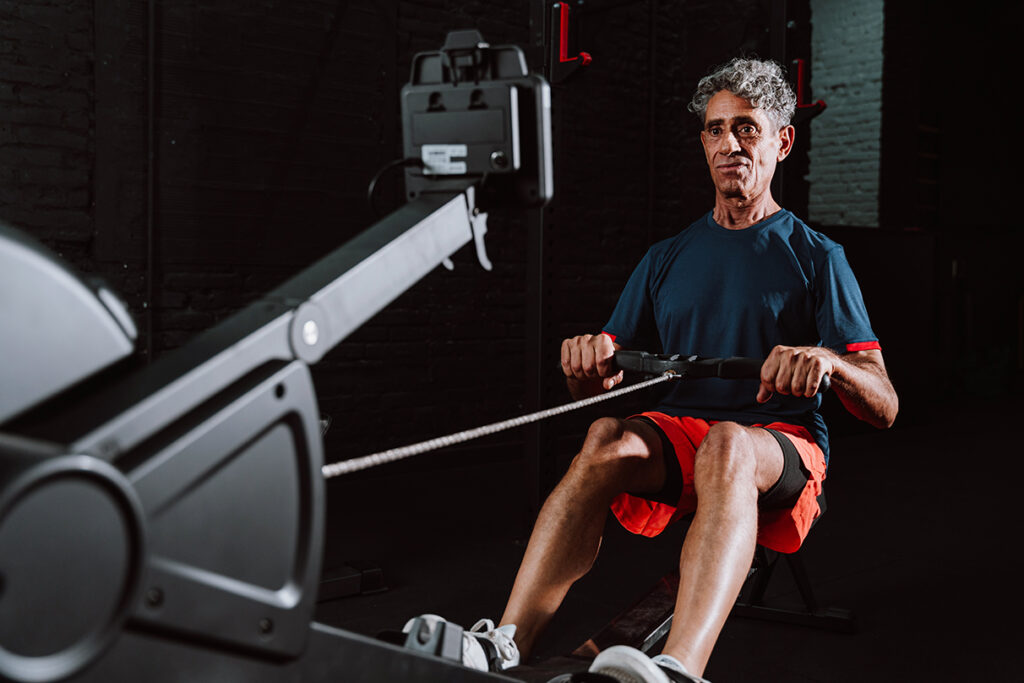Thinking about buying a gym? Whether you’re a personal trainer looking to take your career in a new direction, a fitness enthusiast looking to make it your lifestyle, or an investor eyeing up the lucrative market, this article is for you.
The UK fitness industry is hot right now! According to ukactive, revenue was up 8.8% year-over-year in 2024. And 16.9% of the population hold a membership.
No starting from scratch. An immediate revenue stream. The essentials in place. Buying an established gym can be a strategic choice. Helping you get into the market to take advantage of growth.
Thinking about taking the leap? This comprehensive guide covers everything you need to know before buying a gym – including:
- Choosing the right type
- Asking smart questions
- Spotting red flags
- What to do in your first 90 days after buying a gym
Let’s get stuck in!
Quick takeaways
Short on time? No sweat! Here are your quick takeaways:
- Why buy a gym? Buying an existing gym means an established brand, faster revenue, and lower startup risk than starting from scratch.
- What types of gyms can be purchased? Choose between franchises, independents and boutique fitness studios. Each has unique pros, cons, and investment requirements.
- Where can you find gyms for sale? Check platforms like Sell My Gym or go direct to owners and franchise resales.
- What due diligence checks are needed when buying a gym? Always inspect finances, membership trends, staff contracts, equipment ownership, and the lease when buying a gym.
- Are there any red flags to watch for when buying a gym? Watch for falling membership numbers, expiring leases, poor reviews, unverified finances, and personality-dependent operations.
- What metrics matter when buying a gym? Look at EBITDA, churn rate, member LTV, and debt. A gym with recurring revenue and low overheads is more valuable.
- What next after buying? Focus your first 90 days on stabilising operations, staff retention, member engagement, and rebranding if needed.
Ultimate Guide To Opening A Gym
Free guideWhile this article looks specifically at buying a gym, you might find our broader guide to opening a gym a helpful resource.
Download nowWhy buy a gym instead of starting from scratch?
Starting a gym from the ground up is often seen as the ultimate entrepreneurial challenge. You get full creative control over your brand, location, and offering. Yet it can come at a high cost, with a steep learning curve, and plenty of uncertainty.
By contrast, buying an established gym business can give you a head start. You’re not building something from nothing. You’re stepping into a business that’s already functioning.
“Buying an existing gym offers a significant head start. You acquire an established client base, existing equipment, and often, a recognisable brand, all of which can save you immense time and money compared to building from the ground up. Plus, you’ll typically have immediate cash flow, allowing you to focus on growth rather than initial setup.”
Colin Berry, Sell My Gym
Here’s why that can be a safer move, especially in the competitive UK market:
1. Immediate revenue stream from existing members
Buy a gym with an established membership base and you’re inheriting a regular income stream from day one.
So, you can focus on optimisation and growth. With the average monthly gym membership coming to £48.45 (Leisure DB), this existing revenue can go a long way. Covering fixed costs like rent, utilities, and staff wages.
2. Established brand presence and reputation
It takes years to build a strong brand and reputation. Buying a gym that’s already known in the community gives you a major advantage.
Whether it’s a well-known franchise or a beloved independent gym with loyal locals, you’re not starting from nothing.
Plus, you may also enjoy an established social media following, Google reviews, and SEO rankings that continue to drive sales.
3. Trained staff and proven systems
Recruitment and staff training can be one of the biggest challenges for new gym owners.
Buy an existing operation and you typically gain access to a trained, experienced team. Staff already understand the systems, culture, and members.
When the change is well managed, this continuity helps you maintain a consistent member experience. So, you can focus on higher-level business strategy.
4. Less risk than launching a brand-new business
Opening a gym from scratch requires significant capital investment. And comes with considerable risk.
You’ll be responsible for everything from fit-out costs to marketing. Buy an established gym and many of these initial costs and risks will have already been absorbed.
So, you can analyse real data on things like monthly income, retention rates, cost structures. And make an informed purchase decision based on past performance. No guesswork needed.
5. Equipment, lease, and supplier contracts already in place
Sourcing commercial gym equipment. Negotiating property leases. Setting up supplier accounts. It all takes time and effort.
An existing gym typically comes with these elements already in place. And, while you’ll want to review every contract, having the groundwork already done gives you a platform to build on.
6. Faster route to profitability
When you buy a gym, you skip the setup phase and start with paying members. So, you’re typically closer to breaking even and becoming profitable.
This is especially beneficial if you’re using external financing. Or if you need to show returns to investors or stakeholders.
Deciding which type of gym to buy
When buying a gym, one thing to think about is the type of gym you choose to take on. Base this decision on:
- Your own interests and expertise
- The local market you’re investing in and its demographics
- Your budget
Typical types of gym you can buy include:
- Franchises like Anytime Fitness or Snap Fitness – lean on a well-known name and central support. Although upfront costs can be higher and there’s less operational flexibility
- Independents – going it alone gives you more flexibility. However, you won’t necessarily have much support
- Boutique fitness studios – think yoga, Pilates, and CrossFit. These are great for attracting specific interest groups and may command higher prices
- 24-hour clubs (franchise or independent) – more and more gyms are competing by staying open all the time. These need minimal staff and the right tech and security set up
Go deeper
Find out more about the different types of gym you could buy in the Ultimate Guide To Opening A Gym.
Download for free
Key steps to buying a gym in the UK
Buying a gym is a major financial and professional commitment. Follow these steps to avoid costly mistakes and maximise your investment.
1. Research the market
Always start by getting a clear picture of the fitness landscape in your desired area:
- Assess local demand – Look at other gyms in the area, population demographics, and average income. Tools like ONS provide local data on age, employment, and income levels. Invest in a latent demand site analysis report for any club you’re interested in buying to tell you about the exact potential for growth
- Analyse the competition – Use Google Maps, Facebook and Trustpilot to check out nearby gyms. What are they offering? What are their reviews saying? And how does this compare to the gym you’re thinking about buying?
- Check industry trends – Stay informed about fitness trends and market movements via reports from ukactive and Leisure DB. Considering niche formats like boutique fitness, women-only gyms, or a 24-hour model? Seek out information specific to that niche
2. Find gyms for sale
Once you’ve narrowed down your target location and type of gym, start sourcing opportunities.
Start by browsing listings on online platforms like Sell My Gym, RightBiz, and BusinessesForSale.com.
Speak to commercial estate agents. Most gyms operate from leased premises, so agents often handle gym and leisure facility sales.
Interested in owning a franchise gym? Check their websites for resale opportunities or contact their franchise development teams.
Not all opportunities are publicly listed. So, consider contacting gym owners directly, especially if you’ve noticed declining activity or hints that they may be looking to sell.
Alternatively, engage a broker who understands the fitness industry. They can introduce off-market deals, help with valuations, and guide you through the acquisition.
“While you might find some listings on general business brokerage sites, the best place to find gyms for sale is on specialised platforms like Sell My Gym.
We specifically connect buyers with gym owners looking to sell, providing a curated selection and expert advice tailored to the fitness industry. This ensures you see relevant opportunities and can leverage our expertise.”
Colin Berry, Sell My Gym
3. Visit and evaluate
Once you’ve identified potential businesses to invest in, it’s time to visit in person.
- First impressions matter – Does the gym feel clean, welcoming, and well-maintained? Check signage, lighting, and layout
- Foot traffic – Visit at peak and off-peak times. Is it bustling or empty? Observe member behaviours
- Talk to staff – If appropriate, speak with current employees. Try to understand workplace culture and day-to-day operations
- Equipment and facilities – Inspect the condition and brand of equipment, changing rooms, and other amenities. Will you need to upgrade?
- Location – Is it visible, accessible, and well-located? Is there sufficient parking and/or public transport access?
4. Do your due diligence
This step is critical. You’re not just buying equipment. You’re buying a business. One that will come with assets, liabilities, contracts, and a reputation.
We’ll cover much of this in more detail later in this article, but in general look at:
- Financials – Review profit and loss statements, balance sheets, cash flow, and tax filings for the past 3+ years. Look for trends in membership revenue and seasonality
- Membership figures – Ask for detailed reports on current membership numbers, churn rates, and average length of stay. High churn can signal operational issues
- Staff contracts – Understand employment status, payroll, and holiday entitlement. Plus, review Transfer of Undertaking (Protection of Employment) Regulations (TUPE) implications
- Lease agreement – Review the lease terms. Look at length, break clauses, rent review dates, and transferability
- Licences and compliance – Confirm the gym holds the necessary licences. For example, music (PPL/PRS), liability insurance, and health & safety certifications
- Equipment ownership – Clarify whether gym equipment is owned outright, leased, or under a hire-purchase agreement
- Outstanding liabilities – Check for unpaid invoices, tax debts, or legal disputes
Work with a solicitor and a chartered accountant. Look for ones experienced in business acquisitions and the fitness industry.
“It’s crucial to conduct thorough due diligence.
This includes meticulously reviewing the gym’s financial records, understanding its membership base and retention rates, and assessing the condition of its equipment and facilities. Beyond the numbers, consider the gym’s culture and your vision for its future.
Leisure DB also offers a market research service to ensure that a gym/studio location has the ability to achieve the results you are looking for.”
Colin Berry, Sell My Gym
5. Negotiate and close the deal
Once you’re comfortable with the findings of your due diligence, it’s time to negotiate the terms of the sale.
- Heads of terms – This is a non-binding agreement outlining the key terms (price, payment terms, transfer date, liabilities, etc.). It sets the stage for legal drafting and helps avoid misunderstandings
- Asset vs. share purchase – In the UK, you can either buy the assets (equipment, contracts, goodwill) or the shares of the company. Each has different tax and legal implications, discuss this with your solicitor and accountant
- Final contracts – A sale and purchase agreement (SPA) will legally formalise the deal. This should cover warranties, liabilities, transition terms, and any deferred payments or performance-based earn-outs
- Completion and handover – On completion day, ownership officially transfers. You’ll receive keys, system access, and control of operations. Plan for a smooth staff and customer communication strategy

Burning questions to ask when buying a gym
This is where the deal is done or broken. Asking the right questions during your evaluation process can help you identify:
- Red flags
- Hidden opportunities
- The true profitability of the gym
Go beyond surface-level features and dig into the financials, operations, and future potential.
Here are the burning questions every prospective gym buyer should be asking:
Why is the gym for sale?
While this might seem obvious, it’ll help you understand the seller’s motivation.
Are they retiring? Moving on to another venture? Or are they struggling with declining revenue, increasing costs, or landlord issues?
A vague or evasive answer could signal hidden problems.
What’s the average monthly revenue and net profit?
Ask for at least 3 years of financial records (if the business has existed that long). And look beyond gross income, asking:
- What’s the breakdown between memberships, personal training, classes, and other income streams?
- What’s the seasonality like (e.g. January spike vs. summer drop-off)?
- Has profitability grown or declined year-on-year?
What are the active membership numbers and retention rates?
A large member base doesn’t necessarily mean long-term stability. You need to understand:
- How many active paying members are there right now? And how many have visited in the last month?
- What’s the average retention period?
- What’s the average lifetime value (LTV) of a member?
- Are there any seasonal freezes or suspensions in play?
Seeing high churn or overly discounted memberships? This could be a sign of poor service quality or weak member loyalty.
How old is the equipment, and who owns it?
Fitness equipment can be a major expense. Be sure to ask:
- What’s the condition and age of the cardio and resistance machines?
- Are they owned outright, leased, or under a hire-purchase agreement?
- Are there service contracts or warranties in place?
- Will any leased items transfer to you as the new owner?
Replacing ageing equipment can be costly. So, factor this into your offer price.
Are there long-term contracts with staff, suppliers, or landlords?
Staff and supplier agreements can affect cash flow and flexibility:
- Are any employees on long-term or salaried contracts?
- Do TUPE regulations apply?
- Are there exclusivity deals with supplement providers, software partners, or equipment servicing companies?
- What’s the term and structure of the current lease?
It’s crucial that you and your solicitor review all contracts before signing anything.
What are the key operational costs?
Understanding ongoing operational costs is just as important as knowing the income. Typical recurring expenses include:
- Rent and business rates
- Utilities
- Staff wages and national insurance contributions
- Maintenance, repairs, and cleaning services
- Music licensing (PPL and PRS)
- Insurance (public liability, equipment, building, etc.)
- Marketing and software subscriptions
Ask for a monthly breakdown and identify any contracts with variable or rising costs.
Is the property lease secure and transferrable?
Most gyms operate from leased premises. Make sure to clarify:
- How long is left on the lease?
- Are there break clauses, rent review clauses, or restrictive covenants?
- Is landlord consent required to transfer the lease to you?
- Are there options to renew or expand?
Uncertainty around lease terms can impact your long-term business planning and financing options.
What are the current marketing efforts and local brand recognition?
An established gym should already be known its local area. But is it still actively promoting itself?
- What marketing channels are in use (Google Ads, social media, flyers)?
- Do they have a CRM system or email database?
- How active are their Instagram, Facebook, or TikTok profiles?
- What do Google reviews and Trustpilot ratings say?
- Is the website search engine optimised and generating leads?
You don’t want to start from scratch in terms of digital presence. A well-maintained brand and online funnel can be a huge asset.

Red flags to look out for when buying a gym
The process outlined, and the questions covered, will help you identify any hidden issues lurking beneath the surface.
Spotting red flags early can save you from surprise costs, legal issues, or buying an unviable business.
Warning signs don’t necessarily mean you should walk away. They do call for closer investigation, renegotiation, or a more cautious approach.
“Be wary of inconsistent financial records, a high churn rate among members, or a significant amount of deferred maintenance on equipment. A lack of transparency from the seller or an unclear reason for selling can also be warning signs. Always dig deeper if something feels off.”
Colin Berry, Sell My Gym
Here are some common red flags you should watch for:
🚩Declining membership numbers and/or poor customer reviews
A consistent drop in member numbers could be a sign of deeper problems. For example:
- Poor service
- Outdated equipment
- Weak management
- Increased local competition
Review monthly membership data across 12–24 months to check for negative trends.
Plus, check Google Reviews, Trustpilot, and Facebook for patterns of dissatisfaction. One or two bad reviews is normal, multiple complaints on the same issue isn’t.
🚩Ageing or poor-quality equipment
Equipment that’s 5+ years old, heavily worn, or frequently out of service could require costly replacements or repair. Ask for an inventory with purchase dates and servicing history.
Be cautious if the seller says everything is included “as is” with no warranties. Especially for cardio machines, which tend to wear fastest. Make sure that any leased items will be transferred to you.
🚩Unresolved legal or insurance claims
Pending legal disputes. Staff grievances. Past insurance claims. Any or all of these may suggest negligence or poor risk management.
Confirm that public liability, employer’s liability, and equipment insurance policies are up to date. And make sure they cover appropriate risk levels for the environment.
Ask your solicitor to search for any historic claims, County Court Judgments (CCJs), or employment tribunal records.
🚩Short or unstable lease terms
Location matters for gyms. A weak or expiring lease can threaten business continuity. Avoid leases with less than 3 years remaining, unless there’s a clear renewal option. One that’s confirmed in writing.
Watch for rent increases, no break clauses, or clauses that restrict your operations. Also, find out about any disputes with the landlord.
🚩Overreliance on a single staff member, format, or personality
Some gyms are built around a charismatic owner, lead PT, or one popular class format (e.g. spinning). If that person leaves, or if the format falls out of favour, the business may struggle to retain members.
Assess whether the gym’s success is tied to a sustainable team, proposition and system.
🚩Incomplete or unverified financial records
If the seller can’t produce accurate, recent financials then it’s time to walk away.
Beware of cash-heavy operations where takings aren’t properly recorded. This makes it nearly impossible to value the business correctly. And tough to secure financing.
Plus, watch for discrepancies between claimed revenue and actual membership numbers or Direct Debit income.
🚩Declining community engagement or poor local reputation
A gym that’s lost its community presence will take time and marketing spend to rebuild. Look at the gym’s recent marketing output, community events, partnerships with local businesses, and visibility on platforms like Instagram or TikTok.
Check social media engagement. Look beyond follower counts to likes, comments, and shares. Be cautious if there are no recent posts, very low engagement, or deleted comments on public channels.

Understanding the financials
Let’s cover the all-important topic of finances in more detail!
Before you make an offer, you need a clear picture of the business’ financial health. Past, present, and future.
Examine profitability. Review liabilities. Scope out future investment needs. And calculate whether the gym can provide a return on your investment.
Here’s what to focus on:
EBITDA
In most cases, gyms are valued using a multiple of EBITDA (Earnings Before Interest, Taxes, Depreciation, and Amortisation).
This figure provides a clearer view of a business’ operating performance. One that’s independent of how it’s financed or structured.
Ask the seller or their broker for a “normalised EBITDA” figure. This will strip out one-off expenses or personal costs (e.g. the seller’s car lease or travel).
Key financial metrics
To understand whether the gym is sustainable and scalable, dig into:
- Monthly recurring revenue (MRR) from memberships
- Non-recurring revenue (e.g. PAYG visits, retail sales, personal training)
- Churn rate – the % of members lost each month
- Average member lifetime value (LTV) and cost to acquire each new member (CAC)
- Gross margin – ideally above 60% in most fitness models
- Debt obligations – business loans, equipment finance, unpaid taxes
A gym with solid MRR, low churn, and minimal debt is more valuable than one relying heavily on unpredictable revenue sources.
Watch for hidden costs
Even if the business is profitable today, you may need to invest significantly in the first 6–12 months. These are some of the most common hidden or underestimated costs:
- Equipment upgrades
- Refurbishment
- Rebranding
- Software and other systems
- Staffing
Is the business truly profitable?
Ask probing questions:
- Are profits consistent over time, or were they inflated in one “good” year?
- How much of the profit is reinvested back into the business?
- Are salaries for the owner and family included or excluded in the cost base?
- Are there any large outstanding debts or pending tax liabilities?
Work with a qualified financial expert who understands fitness businesses and UK SME acquisition. They should help with forecasting. Assess net present value (NPV). And check the return on investment (ROI) based on realistic projections.

Doing the necessary legal and operational due diligence
Just like you need to be across the financials, you need to do detailed legal and operational due diligence too. Confirm that the gym you’re buying is legally compliant, operationally sound, and free from hidden liabilities.
In the UK, this process is especially important. Why? Due to strict health and safety requirements, employment laws, and licensing obligations.
Failing to conduct thorough due diligence can leave you exposed. Exposed to legal action, regulatory fines, or unexpected operational disruptions.
Here’s what to focus on:
1. Confirm business licences and legal structure
Use Companies House to confirm the gym is a registered UK business and in good standing.
Gyms don’t require a specific “fitness business licence”. Yet, there are licences to check for:
- A music licence from PPL PRS Ltd is required if music is played in the facility (via speakers, TVs, or classes)
- If food or drink is sold, the premises must be registered with the local authority’s Environmental Health Department
- If the gym offers tanning beds, saunas, or spa treatments, special treatments licences may be required (varies by council)
2. Review insurance cover
Before taking over, make sure the gym has up-to-date insurance and the correct levels of cover. Ask for policy documents and confirm coverage limits, excesses, and renewal dates.
Insurance for gyms
Go deeperGet full details of the different types of insurance you should put in place for your gym business.
Read now➡️3. Review employee contracts and staff status
Get copies of all employment contracts (or self-employment agreements) for staff.
Check whether they’re employees, contractors, or freelancers. This impacts your responsibilities under TUPE regulations (Transfer of Undertakings (Protection of Employment)).
Ask about:
- Wages and pension contributions
- Sick pay, holiday entitlement, and any owed leave
- Non-compete clauses or restrictive covenants
- Disciplinary actions or active grievances
4. Verify member terms and prepaid contracts
Ask to review customer terms and conditions (T&Cs) currently in use.
- Are there long-term contracts in place? Can they be transferred?
- How are cancellations, refunds, and freezes handled?
- How many members have prepaid for months or years in advance?
You may inherit liabilities for unfulfilled prepaid services. Your solicitor should help you structure the sale to account for this, possibly through a price adjustment or seller holdback.
5. Health & safety compliance
Gyms in the UK must meet strict health and safety regulations. These are enforced by the Health and Safety Executive (HSE) and local authorities. Check the following:
- Risk assessments for equipment, cleaning, emergency exits, etc.
- Fire safety compliance – fire alarms, extinguishers, exits, staff fire training
- First aid provisions – trained staff, first aid kits, incident logs
- Maintenance logs – especially for lifting equipment, saunas, or HVAC systems
- Cleaning and hygiene protocols
- Safeguarding policies – essential if under-18s or vulnerable adults attend the gym
Ask whether the gym has had any enforcement notices, accidents, or HSE visits in the past 5 years.
6. Data protection (GDPR) compliance
Failure to follow data protection law can lead to ICO fines and reputational damage. Understand:
- Is the gym GDPR-compliant in how it stores and processes member data?
- What software is used for member management and how secure is it?
- Are marketing emails and texts being sent with the appropriate opt-in consent?
- Does the gym have a clear privacy policy on its website?
7. Review contracts with third parties
Ask for copies of any ongoing supplier contracts. Check for auto-renewal clauses, notice periods, or exit penalties.
Confirm whether lease or franchise agreements are transferable. And whether consent is required from the landlord or franchisor.
“Remember that buying a gym is not just about the tangible assets; it’s also about the goodwill and community built around it. Be prepared to invest not only financially but also personally in nurturing those relationships to ensure continued success. And remember, platforms like Sell My Gym are here to guide you every step of the way.”
Colin Berry, Sell My Gym

What to do after buying a gym
Now for the exciting bit! Once the ink is dry and the keys are in hand, it’s time to shift focus from acquisition to optimisation.
The first 90 days are critical. You’ll be judged by staff, members, and the community. So, making the right moves early can shape your reputation and retention for years to come.
Reintroduce yourself and share your vision
Transparency builds trust. Even more so during transitions.
Hold a team meeting on day one. Introduce yourself. Explain your background. And lay out your vision for the gym. Be open to feedback and ideas from existing staff.
Create a member announcement (think email, signage, and social media). Emphasise continuity (if keeping the same brand) or excitement (if rebranding).
Highlight improvements to come and reassure members their routines won’t be disrupted.
Fix the quick wins
First impressions post-acquisition matter more than you think.
- Tidy up messy corners. Replace burnt-out bulbs. Fix leaky taps. Make small improvements that have a big impact on the club environment
- Refresh changing rooms. For example, with things like new soap dispensers, coat hooks, or air fresheners
- Check the Wi-Fi, app integrations, and online booking systems. Small frustrations can cause churn
- Repaint high-traffic areas for a fast visual lift
Host a relaunch or rebrand event
Whether you’re staying with the same brand, or going in a new direction, take a moment to re-energise the space.
- Invite current members, their friends, local influencers, and community leaders in for a welcome event
- Offer fitness challenges, giveaways, or class tasters to drive engagement
- Promote the event across local Facebook groups, Eventbrite, and via email to your database
Streamline operations with the right systems
Investing in the right gym management software will save time, reduce admin, and improve the member experience.
Look for features such as:
- Online booking and payment
- Automated class scheduling
- Member communication (emails/SMS)
- Attendance tracking and performance analytics
Look for a system like Xplor Gym that’s an all-in-one tool with everything you need in one place. Plus, handy integrations to help you build a customised member experience.
Audit and optimise your digital presence
Being visible and active online will help drive growth. Conduct a digital health check:
- Google Business Profile – Update your address, hours, services, and contact info. Add high-quality photos and a welcoming description. Collect reviews from current members
- Website – make sure it’s mobile-friendly and fast. Include clear calls to action like “Join Now,” “Book a Free Trial,” “Download Our Timetable”. Add trust signals like testimonials and photos of real members
- SEO – Target local keywords like “gym in [town name]” or “fitness classes in [area]”. Use schema markup and location-based landing pages. Find out more about SEO for gyms
- Social media – reintroduce your gym and staff. Share behind-the-scenes content, member shout-outs, and local partnerships. Run low-cost ads to drive awareness and trial offers
Keep an eye on KPIs and set short-term goals
Track the metrics that matter:
- Member growth and retention
- Average revenue per member (ARPM)
- Class attendance and capacity
- Google reviews and NPS (Net Promoter Score)
- Staff satisfaction and turnover
Use this data to guide decisions and continuously improve.
Power up your business & stay in the know
The wrap up…
An immediate revenue stream. An established brand. Trained staff and proven systems. These are some of the benefits of buying an existing gym rather than starting one from scratch.
If you’re looking to become a gym owner (or expand your existing fitness business interests) by buying a gym, you’ll need to understand the local market. Work with industry insiders to find gyms for sale. Do your due diligence to make sure it’ll be a solid investment. And master the art of negotiation to close the deal.
Always work with a knowledgeable, specialist solicitor and a chartered accountant. These professionals should know the right questions to ask when buying a gym and the red flags to watch out for along the way.
Once you’ve acquired your new gym business, make sure you make the right impression in the early days.
That means getting to know and building trust with staff and members. Making quick fixes to benefit everyone. Create excitement around any changes. And start to revamp your digital presence and systems.
Find out how Xplor Gym can help you secure success when buying a gym.

by Xplor Gym
-
First published: 07 July 2025
Written by: Xplor Gym
